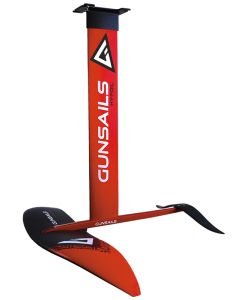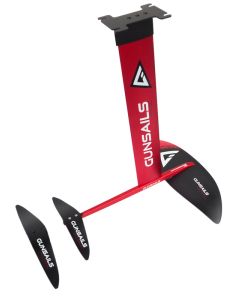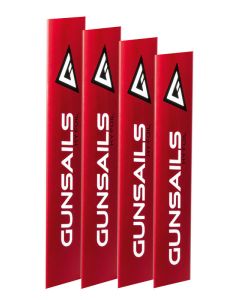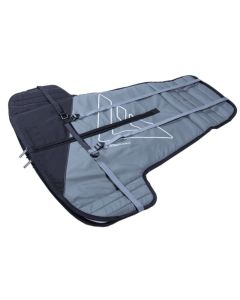All about the HY-FOIL Series and how to choose your setup to get you flying in no time
What is special about the HY-FOIL Series?
Our HY-FOIL bionic wing design has been inspired by the wings of an albatross and the fins of a dolphin, which was hydrodynamically optimized by experts
- Designed & developed by Thilo von Osterhausen with the Gunsails Pro Team and German aircraft engineers and foil surfing afficionados to maximize lift and speed
- We developed our own integral pocket connection system between the fuselage and the frontwing to reduce drag and ensure a bulletproof connection
- In the HY-Series we only use top quality aerospace grade aluminium masts and fuselages – sealed and anodized
- Light weight high modulus carbon with a safer rounded tip design
With a Gunsails HY-FOIL you are sure to ride one of the most efficient hydrofoils on the market.
Which foil setup should I choose?
Granted, not an easy question but it's not rocket science either. Let’s get right to it. A hydrofoil thrives on the interaction of all its components, which are optimally matched to the pilot and the surrounding conditions. It's important to consider your weight, skill level, riding style, and the conditions you'll be riding in when choosing your mast length and wing sizes.
Choosing your front wing size – the importance of aspect ratio:
In wing foiling, the front wing is the key component of the hydrofoil system that provides lift and control to the foil. To select the right foil for you, you need a tiny bit of math. The aspect ratio is a mathematical ratio that describes the shape of the front wing – basically the wingspan divided by wing chord, the mean distance between the leading edge and the trailing edge.
- High Aspect Ratio: Foils very little chord and a large wingspan are more efficient, love higher speeds for racing and furious downwinders. They are therefore not super easy to control and provide less lift but once you’re going, you’re going fast. Check our HY-FOIL FR with its carbon performance mast.
- Medium Aspect Ratio: This is a compromise between both worlds. These foils are great for lighter up & comers to advanced riders that want to carve and jump with ease while still ensuring a lot of progress is possible. Check our HY-FOIL FREE / WING with the smaller – medium front wing sizes.
- Low Aspect Ratio: These foils have a lot of wing surface area (chord) and comparably little wingspan. They are great for beginners with loads of ease of riding and lift for early take offs. First tricks and carving at lower speeds will be amazing with those foils. And they are still great for tricks and carving. Check our HY-FOIL FREE / WING with the medium – big front wing sizes.
Fit with your body weight and skill level:
If you are a light rider, you can choose the smaller front wing, heavy pilots should tend to ride the bigger sizes. For example, a beginner around 75kg or less can ride the 2nd biggest foil size to get started. An 80kg+ surfer should grab the biggest sizes to have the most fun and fast progress fast, unless you are very skilled in board sports and bring several years of windsurfing / kiting experience. Trust us, it’s like volume with surfboards – it’s no fun out there if you ain’t catching any waves.
Regarding the back wing stabilizers: If you buy one of our sets, we have already adjusted the Back Wings to fit the Front Wing sizes in the different sets. The smaller front wings include the 220 carbon back wing, the two bigger front wings our 280 stab.
Choosing the mast on your foil:
When it comes to mast length, the general rule of thumb is to choose a shorter mast for shallower water or for learning the basics of wing foiling. A shorter mast provides greater stability and control, making it easier to balance on the board and control the foil.
On the other hand, a longer mast is better for deeper water and more advanced riders looking to achieve greater speeds and height. A longer mast allows for a greater range of motion and increased lift, which can result in a more exhilarating ride.
All foil set come with a great mast to get you started - usually around 80-85cm.
Choosing the right fuselage:
This is an easy one. To ensure maximum simplicity and modularity, while still offering great performance our HY-FOIL fuselages are all the same optimized length within each collection.
Modularity: how do masts, fuselages and wings fit together? And do they fit across collections?
The Gunsails HY-FOIL sets can be expanded in a modular way. Once you have decided on a set of a certain size, you can customize your next set from a selection of Front Wings, Masts and Back Wings, according to your needs. As aluminium fuselage is the key to the modularity of the foil, it always stays the same.
The alu mast also fits both sets, the HY-FOIL FREE for Windsurfing (Tuttle Box connector) and the HY-FOIL WING for Winging (US BOX Connector). The deep tuttle box carbon mast of the HY-FOIL FR performance windsurf foil only fits the FR fuselage.
What is a Wingsurf Hydrofoil?
A foil is a wing-shaped underwater fin which raises the board to which it is attached from the water once it reaches a minimum speed. This greatly decreases resistance to the water's flow, which in turn increases the speed. Only the lower part of the mast, fuselage and the wings remain underwater, while the mast length determines how high you "fly" above the water.
Hydrofoils consist of different components that affect each other:
Frontwing
Like the wings of an airplane, it is typically the largest and most important part of your setup. The front wing is designed to generate lift as water flows over its curved surface, which raises the entire foil out of the water and allows the rider to fly above the surface. The shape, size, and aspect ratio of the front wing can greatly impact the performance and handling characteristics of the foil and is an important consideration for riders of all levels. Read more below.
Backwing
The smaller back wing, out of high modulus carbon, are also called stabs – meaning stabilizers. Like with front wings, the bigger the back wing, the more stability. But as oftentimes stability comes with a little more drag and less agility.
Masts
Made of aluminium or carbon (lighter, stiffer, more expensive) connect your board with the fuselage of the foil. The wing foil board connects to the foil mast via a standardized padded US Box connector, which fits every US Box Foil Board. Windsurf foil boards usually use the proven, highly durable and globally standardized (deep) tuttle box system. The longer the mast, the less prone to touch downs your setup will be in wavier waters. Shorter masts on the other hand have less flexibility and are easier to handle for beginners.
Fuselage
Like the fuselage of an airplane, the fuselage of a wing foil connects the wings to the mast. The longer the fuselage, the more stable the foil sits under water in its longitudinal axis below the board. Like with an airplane, the longer the fuselage, the hard it is to “pitch” - here meaning to move or potentially pump the nose up and down. This also creates a slower “yaw” - here meaning the radius of your turns will get bigger.
What is the difference in fuselages between Windsurf Hydrofoils and Foils for Wing Surfing?
The fuselages on windsurf hydrofoils and wing foils are different because the two types of foiling systems have different design requirements and performance characteristics.
Windsurf hydrofoils typically have longer fuselages compared to wing foils. This is because windsurf boards are generally larger, longer and heavier than wing foil boards. And the wind energy in the sail is transferred over to the board at the position of the mast’s base, which is over 1 meter in front of the foil’s mast. So, a longer fuselage with a centred mast is needed provide additional stability and to reduce drag.
In contrast, foils for wing surfing have shorter fuselages that are designed to provide greater manoeuvrability and responsiveness. As wing foil boards are typically shorter and lighter than windsurf boards, the fuselage doesn't need to be as long to provide stability and the front wing is right behind the mast.








